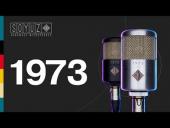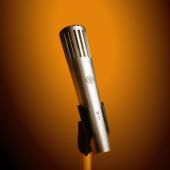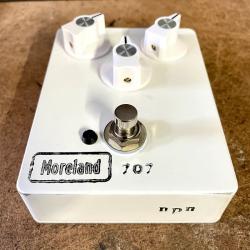Moreland Magnetics 707 Fuzz NPN
Brands:
From the Manufacturer:
"In short, this is my favorite fuzz circuit. My Flagship pedal. Based on the nigh-unobtainable Elka Dizzy Tone (a close cousin to the Burns Buzzaround, and more distantly related to the MkIII Tonebenders), but using a more aggressive transistor set and a few tweaks of my own.
It roars, it snarls, it crumbles, it breathes; the texture is deep and complex, yet pliable and never stiff or opaque. The natural gate snaps the whole world back into context, reminding you how fearfully loud the pedal actually is, in spite of the low noise floor. The controls are interactive, and it's made where every setting sounds good. Also works excellently for bass. This fuzz into a hiwatt will change your life. I could go on and on and on...
The NPN version of the 707 is the same circuit, but with a standard negative-ground power supply scheme. The only real difference this makes is compatibility with daisy-chained power supplies that a PNP positive-ground circuit would short.
Sonically, theres a different color to the texture, something inexplicably clearer and more refined. Hence the white enclosure. The decay crumble is a little more chalky. The cleanup is a bit less gradual. Low gain tones are more delicate. Low end is a pinch more focused. These are my subjective takeaways of this transistor set, but you’ll still get the same roaring snarl and crumbling gate that you’d expect from the most aggressive MkIII variant out there.
Two black glass CV7112 transistors cascade into an Amperex 2N243, carefully selected and audited by ear. It is fair to say that I have most of the remaining stock of this device, and you won't find it anywhere else anytime soon. When I run through this bag, that will be it. For anyone.
-Controls are, from left to right: SUSTAIN, BALANCE, and ATTACK.
Sustain controls the amount of saturation to the third gain stage, fully clockwise can get you into saggy-bottom Neil Young territory.
Balance is the closest thing you have to “volume” however in the strictest sense it does not work the same way. It may more accurately be named “Intensity”.
Attack is somewhat analogous to “tone”, but also does not work the same way. Counter-clockwise is “thinner” and clockwise is “fatter” - it could also be renamed “focus”.
-All three controls are interactive: you may not hear a huge difference in sustain or attack with higher balance settings; you may hear a volume drop with thinner attack settings, and can compensate with higher balance; you may like a lower sustain setting if you have gain stages before the pedal. My favorite setting is all three knobs at 2:00."









